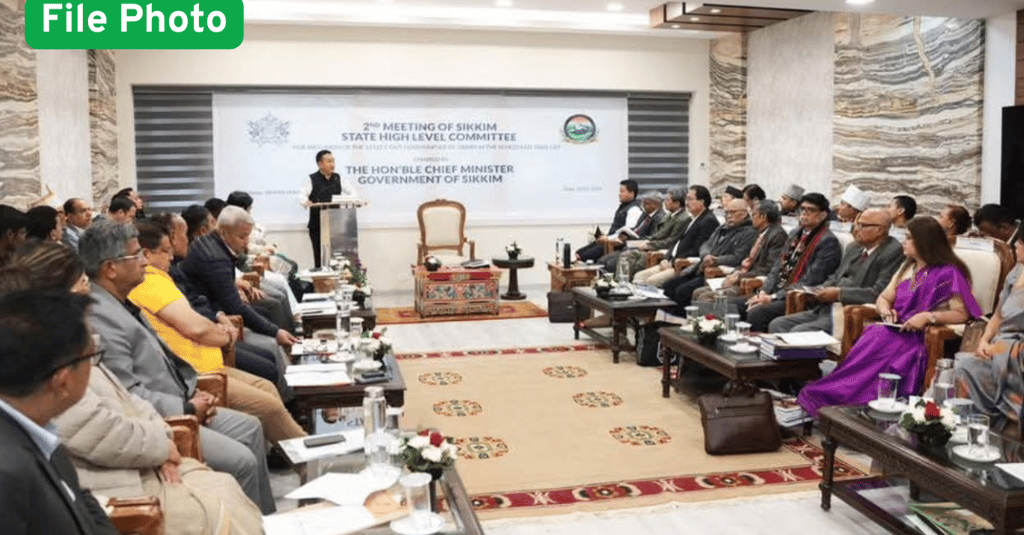Historic Delhi meeting on Sikkim’s tribal status at 1 PM today
The demand for ST status for these 12 communities has been one of the most significant socio-political issues in Sikkim.
LOCAL


A historic and decisive moment awaits today in the national capital as Sikkim Chief Minister Prem Singh Tamang (Golay) is set to chair a high-level meeting that could change the course of the state’s history. The meeting, which will see the participation of senior officials from the Chief Minister’s Office (CMO) and the Social Welfare Department, is expected to mark a major step towards Sikkim being declared a Tribal State, a long-pending demand of its people.
For decades, communities across Sikkim have carried the aspiration of being recognized as Scheduled Tribes (STs). The recognition, they believe, is not merely about constitutional safeguards but also about acknowledging their cultural identity, heritage, and rightful place in the country’s socio-political fabric. Today’s meeting is being seen as a milestone that may bring these aspirations closer to reality.
The people of Sikkim have been waiting patiently for successive governments to take meaningful steps in this direction. Many communities have felt that their history and identity were overlooked, leaving them without the benefits and protection that tribal recognition brings. With this meeting, Chief Minister Tamang is attempting to deliver on a promise that generations have held on to.
Since taking office, Prem Singh Tamang has repeatedly stressed that his government will work for justice, equity, and inclusive development. He has underlined that every community in Sikkim deserves to be heard and represented fairly. Officials close to him say that the Chief Minister views tomorrow’s meeting as not only a political milestone but also as a moral responsibility to the people who have reposed faith in his leadership.
The government’s preparations have been described as “exhaustive,” with detailed groundwork carried out in recent months to ensure that all documentation and procedural steps are in place.
The momentum for tomorrow’s meeting was set earlier this month. On August 2, 2025, the Sikkim government finalized the ethnographic reports of 12 left-out communities seeking ST status. The landmark meeting, held at Samman Bhawan in Gangtok, was chaired by CM Tamang himself and marked the culmination of months of fieldwork and consultations by the State High-Level Committee (SHLC).
The 12 communities under consideration are Bhujel, Gurung, Jogi, Khas, Kirat Rai, Kirat Dewan Yakha, Majhi, Mangar, Newar, Sanyasi, Sunuwar (Mukhia), and Thami. These groups have long demanded tribal recognition, arguing that their histories, cultural practices, and social identities fit the criteria laid down by the Centre.
The SHLC, chaired by Anthropological Survey of India Director BV Sharma and supported by JNU professor Mahendra P Lama as Vice-Chairman, spent months conducting field surveys, consultations with community leaders, and institutional reviews. The committee worked meticulously to address all concerns raised earlier by the central government.
In his social media post after that review, CM Tamang described the documentation as a “living testament to our collective heritage.” He assured that the reports were designed to meet every requirement of the Government of India, expressing confidence that inclusion would soon become a reality.
The demand for ST status for these 12 communities has been one of the most significant socio-political issues in Sikkim. For many, their recognition is also directly linked to the larger demand of making Sikkim a full-fledged Tribal State, something that would ensure wider protection and benefits under the Constitution.
Today’s meeting in Delhi, therefore, is not being viewed as just another administrative exercise. For political observers, it represents a turning point in Sikkim’s modern history. If the Centre responds positively to the state’s push, it would reshape the social and political landscape of Sikkim for decades to come.
Among the communities, there is a sense of cautious optimism. Community leaders have welcomed the Chief Minister’s efforts and urged the Centre to move swiftly. Many ordinary citizens, particularly from rural areas, are hopeful that recognition will bring better access to education, jobs and welfare schemes.
